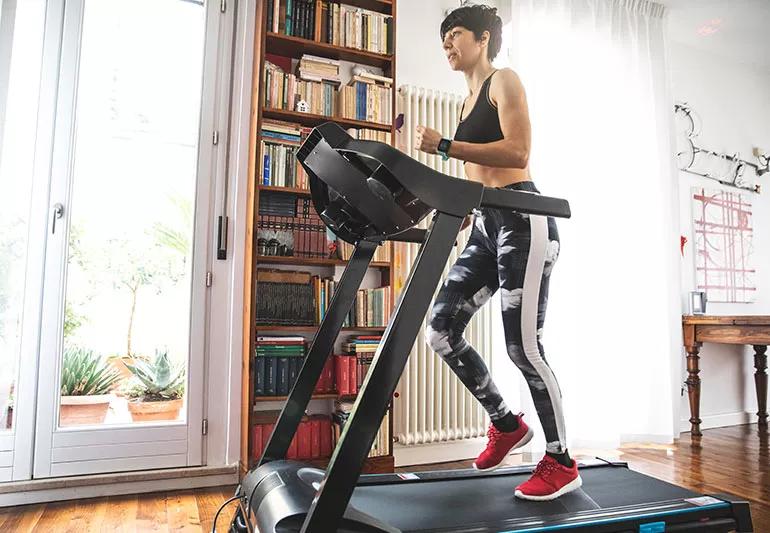Advertisement
Tips to help you improve your cardiovascular fitness

Finally getting back to the gym and ready to hit that treadmill? Or maybe you just bought a home treadmill and are looking for a workout you can do indoors that’s really good for your heart.
Advertisement
Cleveland Clinic is a non-profit academic medical center. Advertising on our site helps support our mission. We do not endorse non-Cleveland Clinic products or services. Policy
A treadmill can be especially good if you live in a cold climate and want to walk or run year-round. Treadmills are easy to operate, their settings can be changed to add variety to your walks or runs, and they are safer than navigating snowy streets and dodging cars and potholes.
The good news is that research shows running on a treadmill can give you the same intensity workout as a run on the road. This means that you can exert the same amount of effort whether they run on a treadmill or run on a track.
Cardiac Rehabilitation Director Erik Van Iterson, PhD, MS, shares some key pointers to help you out, whether you’re starting a new exercise routine or just want to improve your overall cardiovascular fitness.
Rather than striving for speed or distance, focus on reaching your target heart rate training zone, Dr. Van Iterson recommends. “Make it a long-term goal to work towards sustaining this intensity for periods of at least 20 minutes,” he says.
“At first, it is OK if you’re only able to exercise in your heart rate zone for five to 10 minutes before needing a brief break since it takes your body time to adapt to your new routine.” He says you’ll still be able to gradually build your endurance level to the point where you can achieve the national physical activity recommendation of at least 150 minutes of exercise per week in your heart range.
Tracking your pulse (heart rate) is a simple and accurate way to know how hard your ticker is working. For most healthy individuals not taking any heart medications, the following steps can help determine your personal target heart rate range:
Once you know your target heart rate, you’re almost ready to exercise.
“As you learn the settings that allow you to reach your heart rate range, you can vary the speed and incline to change up the activity during the session,” Dr. Van Iterson says.
He adds that steeper grades increase the overall amount of muscle activated and use in your legs. Although this can typically mean more calories burned during incline walking or running, you can also expect a heightened sensation of exertion and earlier fatigue as compared to flat-level exercise.
For variety and additional long-term benefit, mix it up.
“As your conditioning and fitness level gradually begin to improve and you haven’t experienced any chest pain and/or exaggerated shortness of breath while exercising, instead of trudging along at a steady pace for the entire session, think about planning a couple of sessions each week that mix alternating bursts of high and low intensity,” Dr. Van Iterson says.
Advertisement
Follow these patterns:
Your long-term goal is to gradually progress your conditioning level so that you can reach and sustain your target heart rate for at least 20 minutes. So, during your treadmill session periodically stop and take your pulse. You may prefer to use your fitness tracker’s heart rate monitor or an independent heart rate monitor to avoid interrupting the exercise.
“And remember, before you start or change any exercise program, check with your doctor to review the best approach for your personal health needs and goals,” Dr. Van Iterson advises.
Advertisement
Learn more about our editorial process.
Advertisement

Stretch before and after your workouts for maximum benefits, but your pre-workout stretches should be different from your post-workout stretches

This low-impact, full-body workout builds strength and stamina while reducing stress

Exercising can actually improve arthritis symptoms — and low-impact exercises are best

Bulgarian split squats, hack squats and goblet squats are just a few of the moves you can try

Obesity, age and preexisting heart conditions can all raise your risk of cardiovascular disease during pregnancy

While walking, be mindful of your body, your mind, your place in the world and all five of your senses as you pave a path forward, one step at a time

Squat smart with proper technique, including a neutral spine, wide knees and an engaged core

This important step gives your body time to return to its resting state while reducing muscle cramps, dizziness and injury

Focus on your body’s metabolic set point by eating healthy foods, making exercise a part of your routine and reducing stress

PFAS chemicals may make life easier — but they aren’t always so easy on the human body

While there’s little risk in trying this hair care treatment, there isn’t much science to back up the claims